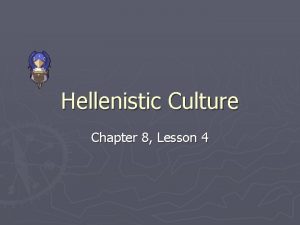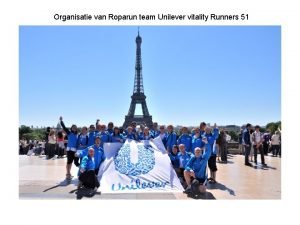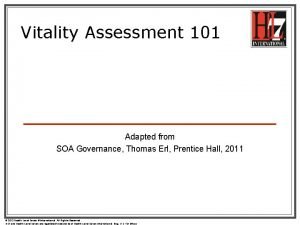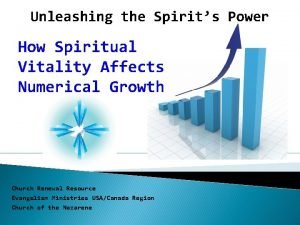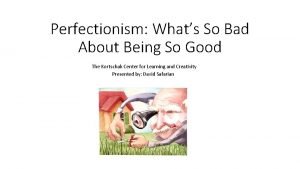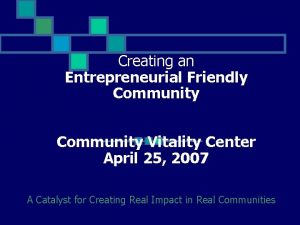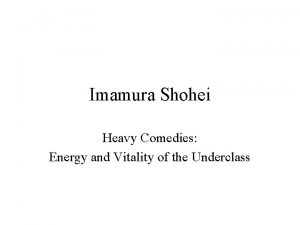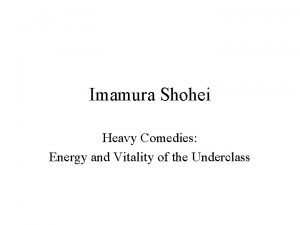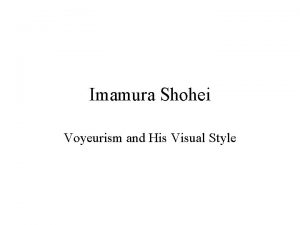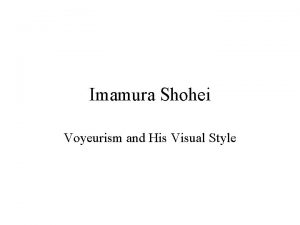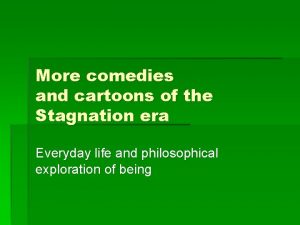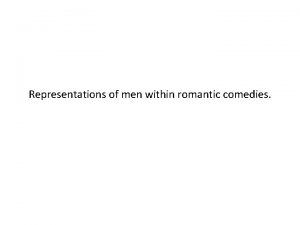Imamura Shohei Heavy Comedies Energy and Vitality of
























- Slides: 24

Imamura Shohei Heavy Comedies: Energy and Vitality of the Underclass

Imamura Shohei ‘I am interested in the relationship of the lower part of the human body and the lower part of the social structure on which the reality of daily Japanese life obstinately supports itself. ’ Immura Shohei (1926 -2006)

Imamura’s Subjects and Themes • Records of Japan’s forgotten regions, neglected people, and oppressed classes. • Lustful impulses and animal desire in human beings, Japanese native customs and rituals, motherliness in Japanese women, infantile tendencies in Japanese men.

Imamura’s Subjects and Themes • Rebel against the studio system • Reacting against the production policy of the studio (Shochiku) • Opposition to the filmmaking style of Ozu Yasujiro, to whom Imamura was an assistant (Tokyo Story e. g. )

Imamura’s Subjects and Themes • Imamura moved to Nikkatsu in 1954 and made his first three films in 1958. • Stolen Desire, Nishi Ginza Ekimae and Endless Love • Clear and well-defined themes from the very beginning • Almost animalistic instinct for life and huge libidinal desire in the people living at the bottom of the social hierarchy or on the margin of the society.

Imamura’s Subjects and Themes • Not the ordered world of Ozu but the hopeless chaos of human existence ‘HEAVY COMEDY’ (c. f. light comedy)

Imamura’s Subjects and Themes • The world of the preand post-war Japan. • Inhabited by the underclass - prostitutes, pimps, swindlers, petit-criminals, pornographers, serial-killers, and shaman • Their comic, pathetic, and raw desire and sexual behaviours • Their insatiable desire for life - food, money, love, sex, but not honour, position, status and appearances

Imamura’s Subjects and Themes • Uneducated people in an itinerant theatre troupe of in Stolen Desire • Traffickers of the morphine found in an underground military storage, Endless Love • Imamura called his films ‘heavy comedy’

• Pigs and Battleships (1961) - story of a teenage thug and his gang who raises pigs on blackmarket garbage, collected from the US marine base in Yokosuka. • Allegory of American military presence and Japanese instinct for survival

Imamura’s Subjects and Themes • Insect Woman (1963) - Tome brought up in the deep countryside in an incestuous relationship with her father.

Imamura’s Subjects and Themes • She moves to a large city working in a factory and then becoming a prostitute. She rises to the grand madam of a brothel and then is replaced by her own daughter. Insect Woman – like a queen bee doomed to be replaced by her daughter.

• Intentions of Murder (1964) • Sachiko, who is stuck in a bad marriage, is raped by a murderer. From shame and hopelessness, she prepares to commit suicide. However, at the last minute she discovers desire to live and comes to be attracted by the rapist.

Imamura’s Subjects and Themes • The Pornographer (1966) - about a man who creates, distributes and exhibits anything pornographic from ‘blue films’ to erotic novels, and from recorded tapes to photographs. The film is also about his relationship with his common-law wife and his stepdaughter.

Imamura’s Subjects and Themes • Vengence Is Mine (1979) • Based on the story of a real -life serial killer, the film traces his life - youth, theft, fraud, murder, manhunt, and capture - in flashbacks and flash forwards, and show those unlucky people who are drawn into his crimes.

Imamura’s Subjects and Themes • Ballad of Narayama (1983) - set in a remote, poverty stricken village, where its tribal custom and law demands that when anybody reaches 70, he/she has to go into mountains to die. The film follows Orin dutifully observes this rule with dignity.

Imamura’s Subjects and Themes • Black Rain (1989) is about the dropping of the A-bomb on Hiroshima, and a family, which survived the blast but were exposed to radiation (black rain) and could not escape horrendous after-effects many years after the fallout.

Imamura’s Subjects and Themes • The Eel (1997) - a businessman sent to prison for eight years for killing his adulterous wife tries to live a quiet life as a barber and to get redemption. His past haunts him and threatens to ruin the equilibrium that he almost obtained.

Imamura’s Subjects and Themes • Dr. Akagi (1998) The time is at the final stage of the Pacific War and Japan is on its way of falling apart and even the remotest part of Japan is not exempt from it. Hardworking but eccentric Dr. Akagi, too, experiences hard-times.

Imamura’s Subjects and Themes • Characters - the underprivileged in urban and rural areas; most of them are involved in illicit, amoral, or illegal activities • Settings (time) - modern, particularly post-war, periods • (location) - remote, rural area left behind from the post-war prosperity and modernization, and urban areas which are only on the margin of prosperity • Actions - associated with criminal, illegal, or amoral actions; sexual actions • Endings - no solution; no redemption

Imamura’s Subjects and Themes • Motif - strong and stubborn women grow even stronger and more resilient through experiencing hardships poverty, failed relationship, male violence, sexual abuse, etc.

Haruko in Pigs and Battleships, Tome in Insect Woman, Sadako in Intentions of Murder

Asano Haru in Vengeance Is Mine, Orin in Ballad of Narayama, Yasuko in Black Rain, and Keiko in The Eel

Motherliness • Imamura’s choice of actresses • Round face, round nose, plump, and large breast • Reflection of motherly quality - image of Japanese mother • Harukawa Masumi and Hidari Sachiko

Warmth of women Salvation brought by women Sakamoto Sumiko, Ogawa Mayumi and Tanaka Yoshiko Boddhisatuba Kannon (goddess of mercy) like figures
 Shakespeare's comedies tend to end with a
Shakespeare's comedies tend to end with a A writer of comedies during the hellenistic era
A writer of comedies during the hellenistic era Shratey calculator
Shratey calculator Subjective perception of vitality and feeling well
Subjective perception of vitality and feeling well Subjective perception of vitality and feeling well
Subjective perception of vitality and feeling well Energy energy transfer and general energy analysis
Energy energy transfer and general energy analysis Energy energy transfer and general energy analysis
Energy energy transfer and general energy analysis Vitality runners
Vitality runners Manulife vitality points chart
Manulife vitality points chart Humana vitality
Humana vitality Generali wellness
Generali wellness Patientsatrisk
Patientsatrisk Ceed vitality
Ceed vitality What is ethnolinguistic vitality
What is ethnolinguistic vitality Code blue scenario
Code blue scenario Fohat
Fohat Learning@broadcom
Learning@broadcom Vitality soa
Vitality soa Spiritual vitality meaning
Spiritual vitality meaning Vitality unsecured
Vitality unsecured Community vitality
Community vitality Why is this happening
Why is this happening Abromil
Abromil Vitality adj
Vitality adj Community vitality definition
Community vitality definition

